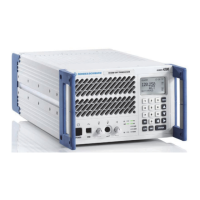R&S XU 4200 Scheduled Maintenance
6166.5368.02.01 5.2
5.1.2 OCXO Adjustment (Optional)
OCXO adjustment
Due to the natural aging of the crystal oscillator (OCXO), it is advisable to
check the frequency offset after the first year of operation and readjust it if
necessary. We recommend a further adjustment interval of 3 years in order
to ensure the specified frequency accuracy.
Note: If the radio is started at low temperatures (approximately −20 °C),
the frequency of the OCXO is far from its nominal value. This causes the
generation of the CBIT message 0315 TX INT REF UNLOCK. When the
OCXO is warmed up, this message will disappear. This is a typical behavior
of radios with the OCXO installed and not an indication of a radio failure.
Test connection
Fig. 5.2 Test connection of OCXO adjustment.
Test procedure
DUT is controlled via the R&S ZS 4200 (see chapter 3.3).
The minimum warm-up time is 10 minutes for the
OCXO. The OCXO
OVEN WARNING must disappear before the OCXO can be adjusted.
Test frequency: 120 MHz (see chapter 3.4.7.2)
Power level set: Low (see chapter 3.4.7.2)
Mode:
AM (se
e cha
pter 3.4.7.2)
Radi
o is keyed ON, e.g. via function Test PTT, whi
ch delivers an
unmodulated CW signal (see chapter 3.4.7.4.1).
Measure frequency at an
tenna X3 and adjust OCXO value using
the Service & Maintenance Tool R&S ZS 4200 (see chapter 3.3).
The step width (1 bit) for the adjustment is app
roximately 1.5 Hz.
Adjust it only in small steps and do not detune the OCXO to the
extreme positions, because the internal reference on the RF module
could unlock here (CBIT error 0108, see chapter 4.2.1).
Nominal value
OCXO f ±0.02 ppm (co
rresponds to ± 2.4 Hz at 120 MHz)
D.U.T.
X3
ATT
30 dB
Spectrum
analyzer/
frequency
counter

